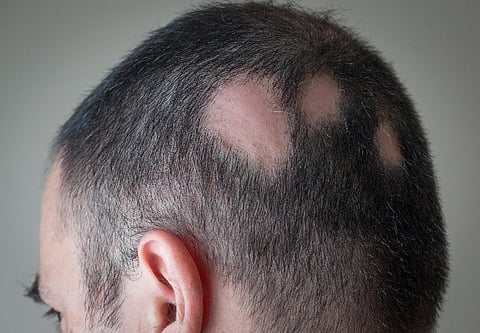MONDAY, May 13, 2024 (HealthDay News) -- Early research in mice suggests a new path forward to restoring hair growth in people affected by a form of alopecia.
Alopecia areata is an autommune disorder that affects an estimated 6 million Americans and has no cure, according to researchers at the Massachusetts Institute of Technology (MIT) in Boston.
The condition causes immune system T-cells to attack hair follicles, causing hair thinning and bald spots.
Patients who can tolerate it resort to injections into the scalp of immunosuppressant steroids to help ease the condition. Others might turn to immunosupressant pills, but that can bring its own problems.
“This approach silences the entire immune system, offering relief from inflammation symptoms but leading to frequent recurrences," said study co-senior author Natalie Artzi, a principal research scientist in MIT’s Institute for Medical Engineering and Science. "Moreover, it increases susceptibility to infections, cardiovascular diseases, and cancer.”
Her team decided to explore a new approach: A patch containing myriad microneedles that is applied to the scalp. It releases drugs to reset the immune system so it stops attacking follicles.
“This innovative approach marks a paradigm shift," Artzi said in an MIT news release. "Rather than suppressing the immune system, we’re now focusing on regulating it precisely at the site of antigen encounter to generate immune tolerance."
The treatment appears to be working, in mice at least. Mice given the microneedle patch showed hair regrowth and significantly reduced levels of inflammation where the patch was applied.
Furthermore, the dangerous systemic effects of oral steroids were avoided, researchers found.
Atzi and co-senior author Dr. Jamil Azzi, an associate professor at Harvard Medical School, note that the microneedle technology is unique in that, unlike a topical cream, it allows drugs to pass through the skin's tough outer layer.
The drugs included in the experimental patch are cytokines IL-2 and CCL-22, immune molecules that help to recruit regulatory T cells and reduce local inflammation.
In essence, the therapy helps train the immune system to recognize follicles as friends, not foes that must be attacked, the researchers explained.
The patch might even be used to monitor how well treatments are working, they added.
The research has so far only been conducted in mice, and experts note that many trials that work well in animal models fail to pan out in people.
Still, the Boston team is optimistic and is planning to launch a company to further develop the technology. They also hope that microneedle patches might also be used to battle other autoimmune skin diseases.
The findings were published recently in the journal Advanced Materials.
More information
Find out more about Alopecia areata at the National Institute of Arthritis and Musculoskeletal and Skin Diseases.
SOURCE: Massachusetts Institute of Technology, news release, May 9, 2024


